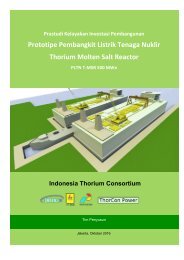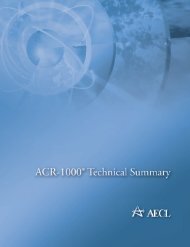MSR Review
EPD MSR Review Feasibility Study July 2015 1.02
EPD MSR Review Feasibility Study July 2015 1.02
Create successful ePaper yourself
Turn your PDF publications into a flip-book with our unique Google optimized e-Paper software.
<strong>MSR</strong> <strong>Review</strong> - Appendix A<br />
<strong>MSR</strong> 4 – Seaborg Technologies – Seaborg Waste Burner (SWaB)<br />
The SWaB prototype proposal is a 50MWth single fluid reactor that operates in the thermalepithermal<br />
spectrum. It is graphite moderated and fuelled by a combination of spent nuclear fuel<br />
and thorium. The design team based in Denmark, is a combination of physicists and chemists<br />
from the Niels Bohr Institute and the Technical University of Denmark.<br />
The fuel salt is a lithium-7 fluoride with dissolved thorium and fissile actinides from spent nuclear<br />
fuel. This is pumped through the graphite core and heat exchanger into a hold tank which is an<br />
important safety device. In most accident scenarios the fuel flows from this hold tank into a drain<br />
tank where it is rendered subcritical. A ‘freeze valve’ ▲ also exists as a secondary safety feature.<br />
The core itself consists of hexagonal graphite columns through which the fuel salt flows in the<br />
centre. An operating temperature of 700˚C is maintained by a secondary flow of coolant salt.<br />
The reactor relies on a novel, patent pending, on-board chemical fluorination flame reactor,<br />
based on the Fluorex process which can continually extract fission products from the salt during<br />
operation. This reprocessing system can process spent fuel pellets from conventional reactors<br />
whilst removing the uranium for other uses. The system is also used to adjust the fuel levels in the<br />
salt, avoiding the need for control rods. Shut down rods do exist in the core but primary reactivity<br />
control is via the coolant salt pump which changes the temperature of the fuel salt in the core<br />
thus altering reactivity due to its strong negative reactivity coefficient. This is a common feature<br />
to all <strong>MSR</strong> configurations.<br />
The inner vessel is formed of Hastelloy-N. A second barrier exists around the core and heat<br />
exchanger made of boron carbide clad in Hastelloy-N. This acts as a neutron and heat shield<br />
and as primary containment in the event of an extreme accident scenario where the inner vessel<br />
fails. The core, hold tank and off-gassing system are contained within a Ni-alloy vessel (3rd<br />
barrier). Finally, the core, reprocessing system, and dump tank are contained within a steel dome<br />
under large blocks of concrete underground.<br />
Figure A8<br />
Schematic of reactor<br />
▲ see Glossary<br />
Figure A9<br />
Illustration of SWaB reactor in sealed container style unit<br />
under several concrete slabs<br />
Energy Process Developments Ltd. 50





